What’s it like to live in the aftermath of a nuclear disaster?
- Text by Alex King

The Chernobyl disaster on April 26, 1986 remains the most serious nuclear accident in history. It was an enormous tragedy, made up of scores of smaller tragic stories: from the relief workers who were unnecessarily exposed to dangerous levels of radiation because they weren’t briefed properly, the babies aborted – again, unnecessarily – after being exposed to radiation, and the estimated 4,000-200,000 people who have died as a result.
The explosion of reactor No. 4 at Chernobyl Power Plant eventually led to the evacuation of 53,000 people in the surrounding area. The town of Pripyat, where the workers lived, was emptied to become a ghost town, surrounded by an eery 30 km exclusion zone.
Nikolaus Geyrhalter’s haunting documentary 1999 Pripyat meets the people who still live in this radioactively contaminated no-man’s land: power plant workers who still operate reactor No. 3 (separated by just a wall from the destroyed reactor), scientists and researchers who monitor radiation levels and do their best to stop the contamination spreading further, and villagers who refused to or couldn’t leave the area.
Shot in verité style, the film calmly follows the enthusiastic power plant worker, the jaded researcher and the bickering pensioners who compete to finish the other’s sentences; whose lives would be unremarkable if not for the utterly surreal environment in which they work, eat and – worryingly – farm and fish.
Slowly, each person reveals how they’ve attempted to make sense of the accident and the weight of coping with life in a disaster area.
Director Nikolaus Geyrhalter looks back on the making of his monumental documentary.
Do you remember where you where when you learned of the Chernobyl disaster?
I was 14 years old when the Chernobyl accident happened. I remember that everybody was very worried because we learned about the accident only days after it had happened. Those were nice spring days and people had enjoyed their weekend outside, not knowing that the environment was highly polluted by radioactivity. All at once people were recommended to stay in, and they found out that water and food was contaminated.
Why are people continually fascinated by Pripyat?
Generally people are fascinated by abandoned places, because it looks like our future can be foreseen there.
Pripyat, especially, was a very modern town, one of the places where the communist utopia apparently worked out surprisingly well. It is a unique place in that sense, and it is still well-preserved except for the nature that has taken it over. This makes it so unique.
Were there any people or moments that particularly stood out for you while shooting?
To be honest, filming is too way back for me to remember details. But I can say that we haven´t met one single person in the exclusion zone who was not extremely kind and helpful to us. Living and working there is not an easy task, and people are forced to stick together. They all fight the same invisible enemy every moment of their lives, which makes them stick together, irrespective of their profession or legal status.
What was the most challenging aspect about making the film?
The most challenging aspect was obviously to find a way to make this film at all. Radioactivity was the greatest concern, and we had ourselves scanned for radiation before and after every period of shooting in a lab here in Vienna. On location we were using Geiger-counters and dosimeters, and had to wear protective masks on dry windy days. We were very concerned about this danger, although you tend to get used to it pretty quickly.
What are the most important lessons we can draw from Chernobyl? Do you feel we as a society have learned these lessons?
Nuclear power plants can never be 100% safe. And worldwide there is not one radioactive waste repository that could be considered safe. This lesson could have been learnt at other occasions before or after Chernobyl as well, but I cannot see that this has actually happened. Greener and cheaper technologies to produce electric power are available, but the industry opposes the decentralised production of electricity at regional level wherever they can.
Pripyat was shown in the Barbican’s Architecture on Film series, in partnership with the Architecture Foundation.
Latest on Huck

How Labour Activism changed the landscape of post-war USA
American Job — A new exhibition revisits over 70 years of working class solidarity and struggle, its radical legacy, and the central role of photography throughout.
Written by: Miss Rosen

Analogue Appreciation: Emma-Jean Thackray
Weirdo — In an ever more digital, online world, we ask our favourite artists about their most cherished pieces of physical culture. Today, multi-instrumentalist and Brownswood affiliate Emma-Jean Thackray.
Written by: Emma-Jean Thackray

Meet the shop cats of Hong Kong’s Sheung Wan district
Feline good — Traditionally adopted to keep away rats from expensive produce, the feline guardians have become part of the central neighbourhood’s fabric. Erica’s online series captures the local celebrities.
Written by: Isaac Muk

How trans rights activism and sex workers’ solidarity emerged in the ’70s and ’80s
Shoulder to Shoulder — In this extract from writer Jake Hall’s new book, which deep dives into the history of queer activism and coalition, they explore how anti-TERF and anti-SWERF campaigning developed from the same cloth.
Written by: Jake Hall

A behind the scenes look at the atomic wedgie community
Stretched out — Benjamin Fredrickson’s new project and photobook ‘Wedgies’ queers a time-old bullying act by exploring its erotic, extreme potential.
Written by: Isaac Muk

“Welcome to the Useless Class”: Ewan Morrison in conversation with Irvine Welsh
For Emma — Ahead of the Scottish author’s new novel, he sat down with Irvine Welsh for an in-depth discussion of its dystopic themes, and the upcoming AI “tsunami”.
Written by: Irvine Welsh